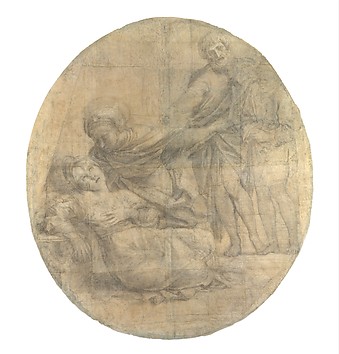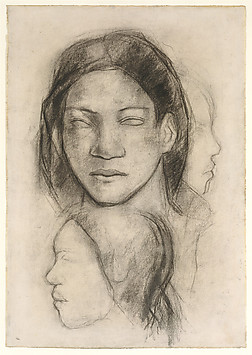
Charcoal

Clockwise from lower left: powdered charcoal, chamois cloth, erasers, stumps, willow twigs, charcoal sticks, charcoal crayon
Charcoal is made from twigs of willow or vine that have been heated at a high temperature in an enclosed vessel without oxygen. This process yields a solid drawing stick that produces a black line when stroked across a sheet of paper, a prepared canvas, or a wall primed for fresco.
The minute, splinter-like particles of charcoal readily crumble when spread onto these supports, producing great diversity of marks and varied richness of tone. Because charcoal particles are relatively large and the sticks do not contain a binding agent, the medium is easily manipulated with either a finger, paper, or pieces of leather. To hold the medium in place, charcoal requires paper with some texture, and to prevent smudging many artists apply a fixative to finished drawings.

Charcoal is invariably dark gray to black. Stroking charcoal across a surface produces linear effects. Varying the angle at which the stick is applied, as well as the pressure of the hand, achieves either narrow or broad lines.

Broader, more painterly masses can be made by using the side of the charcoal stick, or by stumping (spreading the particles) with a finger, chamois cloth, cork, or other soft material.

The large particle size and absence of a binder allow charcoal to be lifted easily from paper, enabling an artist to make corrections or create highlights using, for example, a kneaded eraser, as seen below.

Charcoal has remained a popular medium for drawing since the Renaissance. At that time, it was used for preparatory purposes: to develop initial ideas, preliminary outlines, areas of shadow, or for squaring grids used to transfer a design to another surface.
Francesco Salviati (Francesco de' Rossi) (Italian, 1510–1563). Saint John the Evangelist (recto; Cartoon for a Fresco) (detail), 1548–49. Charcoal, highlighted with white chalk, on blue paper; outlines heavily stylus-incised, 20 7/16 x 9 5/8 in. (51.9 x 24.4 cm). The Metropolitan Museum of Art, New York, Purchase, Lila Acheson Wallace and Leon D. and Debra R. Black Gifts, 2001 (2001.409a, b)
In the nineteenth century, artists used charcoal to make highly finished drawings. Such works often feature textural effects, scraping, the mixing of water or other liquids with charcoal powder, stumping, and various reductive techniques such as erasing.
Adolphe Appian (French, 1818–1898). A Pond with a Fisherman along the River Ain, 1868–70. Charcoal and black chalk over printed plate tone, 21 5/8 x 38 1/4 in. (54.9 x 97.2 cm). The Metropolitan Museum of Art, New York, Purchase, Gift of Mrs. Gardner Cassatt, by exchange, 1998 (1998.359)
The medium is prized for its ability to produce an interplay between light and shadow known as chiaroscuro. By the end of the eighteenth century, the introduction of fabricated charcoal (powdered and recompressed to different degrees of hardness) provided the artist with an even greater expanded range of dark grays and blacks. Artists further enhanced the medium with touches of pastel or gouache (opaque watercolor), or by applying toned fixative to the paper to darken the support. Odilon Redon used the latter technique in Armor, seen below.
Odilon Redon (French, 1840–1916). Armor (detail), 1891. Charcoal and conté crayon, 20 x 14 1/2 in. (50.7 x 36.8 cm). The Metropolitan Museum of Art, New York, Harris Brisbane Dick Fund, 1948 (48.10.1)
Marquee image: Léon-Augustin Lhermitte (French, 1844–1925). The Cider Jug (detail), 1874. Charcoal on laid paper, 15 15/16 x 21 7/8 in. (40.5 x 55.5 cm). The Metropolitan Museum of Art, New York, Anonymous Gift, 2003 (2003.595)






